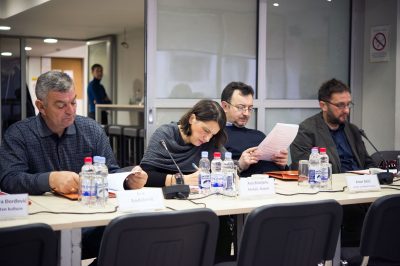The Centre for Nonviolent Action started working on the Peacebuilding Strategy already in 2010, taking as its starting point its years of working in the region and the desire to use its activist approach to start a process of institutionalising a sustainable peace and cross-border cooperation. In the first phase of drafting the Peacebuilding Strategy, numerous activists from Serbia and the region were interviewed, particularly those with experience in institutionalising and creating a legislative framework. Because the interviews showed that there was a significant need to create a strategic document in this area, for both Serbia and the region, the more protracted and complex phase of its drafting was started. The draft version was completed during the past six months. In the previous period we also organised meetings with state institutions and independent bodies, and with organisations from Serbia that share our values, where we presented the idea and concept behind the Peacebuilding Strategy and discussed possibilities to have the document officially adopted. Meetings were held with representatives of: the Ministry of Education, the Ministry of Culture, the Ministry of Internal Affairs, the Ministry of Youth and Sports, the Office for Cooperation with Civil Society, the Office of the Ombudsperson, the Office of the Commissioner for Data Protection, the Office for Human and Minority Rights, the Office of the Commissioner for Equality and the Team for Poverty Reduction. We contacted a number of other institutions and organisation, but did not receive a reply and were unable to schedule a meeting.

Apart from useful and detailed advice, all the meetings also provided encouragement to continue our activities and assurances that the need for this type of document was recognised as important for Serbia and the region. This fortified our decision to organise a meeting in the form of a Dialogue Circle on 8-9 November 2016 attended by representatives of institutions as well as our partners from the non-governmental sector in the region, as well as a number of war veterans that have worked with us. Our aim was to go through the major dilemmas we still have regarding the Peacebuilding Strategy together and to hear what potential impact the adoption of this Strategy might have on Serbia and the region, as well as about the possibilities and necessary steps to adopt the Strategy.
The Dialogue Circle was attended by our seven partner organisations from the region and representatives of seven state institutions of the Republic of Serbia, in addition to members of the Centre for Nonviolent Action. The dialogue was divided into four main sections: content issues and dilemmas, possibilities and needs for institutionalised regional cooperation, planning of responsible bodies and proposers of the Peacebuilding Strategy, and defining next steps.
In the lively and inspirational dialogue, we heard that this was the right moment for such a document and political vision, that the biggest problem (as it seems now) is not the adoption of the Strategy by the state, but its monitoring and implementation. Although it is not a priority at this stage, we also discussed the issue of potential responsible bodies and other possible partners. One suggestion was to gradually introduce the public, through a specially designed campaign, to the concept of peacebuilding. a.
With gratitude to all the participants of the Dialogue Circle, it is now up to us to discuss the recommendations we received and do what is necessary to find a proposer for this important strategic document, given that its adoption will ultimately depend most on a political decision by the government.
Katarina Milićević
Peacebuilding Strategy – Summary
Due to the effects of war, suffering and post-war policies, there is great distrust among members of different ethnic groups in the Balkans. It is, therefore, necessary to systematically engage in processes of reconciliation and dealing with the past. The proposed Strategy pertains to the Republic of Serbia that would take on the responsibility of being the first to consider this strategic document, thereby symbolically extending a hand in reconciliation, and would formally adopt the Strategy as its long-term policy.
Reconciliation is a future-oriented process that aims to create a sense of security and certainty that past violence will not be repeated. The drafting of the Peacebuilding Strategy incorporated views from neighbouring countries, which is a new practice and a practical manifestation of the principle by which fostering and sustaining peace entails a constant process of communication in interdependent societies of informed citizens. It should arise from a process of exchange, critique, debate and cooperation between all people whose lives it affects. The process of bringing forth ideas that foster peacebuilding is not one conducted among like-minded people, but must also take into account the voices of those who see “others” as enemies or threats, it must contain multiple perspectives, be multidisciplinary and encourage free thinking.

In that sense, the Peacebuilding Strategy is based on the values of respecting differences and the equality of individuals, dialogue, cooperation, social justice and solidarity among individuals and groups in decision-making processes about how to meet the needs and protect the rights of individuals, one’s own and neighbouring communities.
The Draft Strategy comprises three domains: reconciliation, peace education and dealing with the past. Strategic objectives have been defined for each domain, as well as activities divided by specific fields (e.g. education, foreign policy, security, international cooperation, etc.).
The proposed Peacebuilding Strategy recognises and relies on existing legislation and standards, but also contains proposals for improving the social situation and for introducing European standards in many areas.
The aim of the Peacebuilding Strategy is to create effective mechanisms and activities for creating sustainable peace and a stable social balance where conflicts do not escalate into violence and war. It entails a change of social relations that are at the root of the conflict, as well as creating a space to resolve conflicts in a fair was through cooperation and trust building.